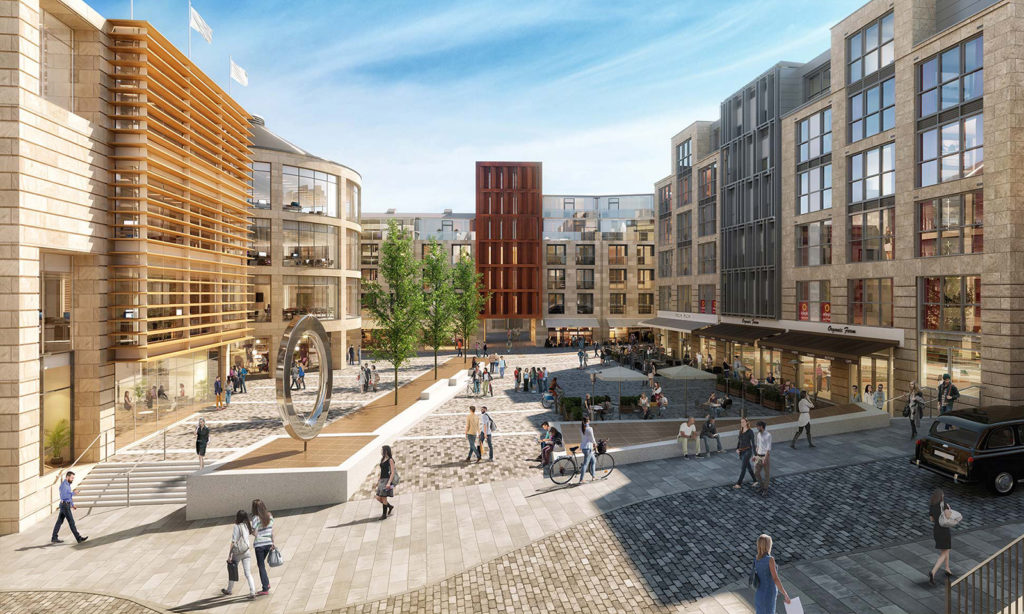Mixed-use developments offer benefits to residents, businesses and even local councils, and their popularity is growing across Scotland. In this latest Insight piece, Queensberry Properties explores further.
In the 20th century, house building was generally a siloed activity. Property firms might have been working within a wider master plan, but they were rarely tasked with anything other than constructing homes. Even in New Towns like East Kilbride, there were clear distinctions between responsibility for the various residential, commercial and industrial districts. And more recently, suburban sprawl saw thousands of homes being built on greenbelt land across Scotland, with barely a corner shop or post office between them.
To a lesser extent, this still holds true in suburbs on the periphery of our cities. However, mixed-use developments represent an increasingly common alternative to residential-only schemes. A builder (or a consortium) creates a development intended to achieve multiple uses, such as apartments above new retail units. Developers might construct a school alongside family homes, or create a library and community centre at the heart of mixed-tenure houses and flats.
Different class
To be classed as mixed-use, a development must contain more than one type of building. In Scotland, these include class 1 (shops), class 7 (hotels), and class 9 (housing). A blend of different classes is often crucial in terms of obtaining planning approval, particularly in areas where limited existing resources would be bolstered by mixed-use proposals. Simultaneous construction and occupancy ensures amenities are up and running as soon as residents move in, while the providers of those services enjoy healthy demand from the outset.
Mixed benefits
There are numerous benefits to mixed-use developments, which are gradually becoming more common across Scotland. Residents have amenities on their doorsteps, while businesses have an instant market for their offerings. Dependence on public or private transport is reduced if people have pedestrian access to places of work or recreational amenities, though visitors may be attracted from elsewhere if non-residential elements are different to those already available locally.
Mixed-use developments tend to be fairly dense, making greater use of available land. Vertical developments (like mid-rise apartments above office units) are ideal for constrained or compact brown field sites. Developers can also collaborate with councils to address local supply-and-demand imbalances. In a town with lots of empty retail units but overflowing classrooms, the local council might stipulate a mixed-use master plan must contain a primary school campus but no shops.
Mixed-use developments can help local councils to deliver tangible community benefits, alongside reduced demand for existing services like public transport. The promotion of mixed-use developments is now listed as one of the twelve core planning principles contained in the National Policy Planning Framework. Little wonder that mixed-use plans often provide the most straightforward path for developers to obtain planning permission for larger developments.
Something Old, something New
Going forward, Queensberry Properties will play a key role in some of Scotland’s leading mixed-use developments. A prime example is the £200 million New Waverley scheme in the heart of Edinburgh’s historic Old Town, which is a great model of a coherent mixed-use master plan, regenerating brown field land in sympathy with its surroundings. Our apartments, mews houses and maisonettes at Waverley Square will stand adjacent to 160,000sq ft of office space – potentially shortening the daily commute to a stroll across a landscaped wynd.
New Waverley will also contain dozens of retail units, hotels and a public square. And although central Edinburgh’s innumerable amenities are within walking distance, residents could comfortably live, work and socialise entirely within this 7.5-acre site. New Waverley promises to be one of Scotland’s most successful mixed-use developments and it ably demonstrates what can be achieved with a coherent master plan.

